Super Color Cluster Feather Dusters
Bispira brunnea
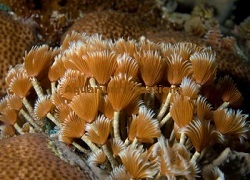
A colorful mass of tiny feather dusters.
Description:
A beautiful addition to any reef tank. Very hardy (no need to worry about keeping these), may be kept under virtually any light conditions.They grow as a mass of individual small tubeworms, sometimes totaling over 100 in a single clump. Their parchment-like tubes will adhere to bits of rock. This helps to anchor the clump, which will usually be found in a shaded area of the reef. In the reef aquarium, they will require space under an overhanging rock or coral, with a gentle current delivering their planktonic meals. Since they need plankton in their diet, they will do best in a mature reef aquarium. Their combined mass of colorful radioles will filter out the available floating plankton, but can also be withdrawn into the parchment tubes if alarmed, and they are easily alarmed. If they become continually frightened or subjected to poor water quality, they may discard their radioles (fan tentacles). They will be re-grown only under proper conditions. Their mass of tubes are somewhat delicate, so care should be taken while transporting them. They should not be housed with predatory fish, serpent stars, urchins or any other invertebrate that may break them apart.
Tank Recommendations:
The ideal aquarium for Fan Worms is one with plenty of live rock, a sand bed, and invertebrate friendly inhabitants. Feather Dusters should not be kept in reef tanks with Angelfish or Butterflies, which prey on them. It is important to maintain good water conditions since Fan Worms are unable to tolerate poor water conditions or sudden changes in temperature or salinity. When they are stressed, Fan Worms will shed their feather-like crown but they will re-grow this crown unless the stress is a result of poor environmental conditions. It is very beneficial and possibly necessary to regularly stir the sand in the aquarium, not only to feed the worms but also to aerate the sand bed.
Food and diet:
Feed marine snow, phytoplankton, and/or foods for filter feeders.
Level of Care: Easy
Reef Compatibility
:Excellent
Approximate Purchase Size:
1" clump of dusters
|
Price Each $21.99 ea.
Pack of 3 $59.97 ($19.99 ea.)
|
Purple Cluster Feather Dusters
Bispira brunnea
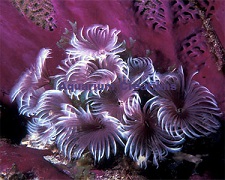
A colorful mass of tiny feather dusters.
Description:
A beautiful addition to any reef tank. Very hardy (no need to worry about keeping these), may be kept under virtually any light conditions.They grow as a mass of individual small tubeworms, sometimes totaling over 100 in a single clump. Their parchment-like tubes will adhere to bits of rock. This helps to anchor the clump, which will usually be found in a shaded area of the reef. In the reef aquarium, they will require space under an overhanging rock or coral, with a gentle current delivering their planktonic meals. Since they need plankton in their diet, they will do best in a mature reef aquarium. Their combined mass of colorful radioles will filter out the available floating plankton, but can also be withdrawn into the parchment tubes if alarmed, and they are easily alarmed. If they become continually frightened or subjected to poor water quality, they may discard their radioles (fan tentacles). They will be re-grown only under proper conditions. Their mass of tubes are somewhat delicate, so care should be taken while transporting them. They should not be housed with predatory fish, serpent stars, urchins or any other invertebrate that may break them apart.
Tank Recommendations:
The ideal aquarium for Fan Worms is one with plenty of live rock, a sand bed, and invertebrate friendly inhabitants. Feather Dusters should not be kept in reef tanks with Angelfish or Butterflies, which prey on them. It is important to maintain good water conditions since Fan Worms are unable to tolerate poor water conditions or sudden changes in temperature or salinity. When they are stressed, Fan Worms will shed their feather-like crown but they will re-grow this crown unless the stress is a result of poor environmental conditions. It is very beneficial and possibly necessary to regularly stir the sand in the aquarium, not only to feed the worms but also to aerate the sand bed.
Food and diet:
Feed marine snow, phytoplankton, and/or foods for filter feeders.
Level of Care: Easy
Reef Compatibility
:Excellent
Approximate Purchase Size:
1" clump of dusters
|
Price Each $33.99 ea.
|
Coco Worm: Hard Tube
Protula bispiralis
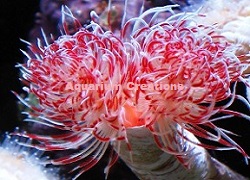
Description:
Hard tube coco worms secretes a calcareous tube approximately 1/2 inch in diameter and 5"-8" long. The tubes come bent in all sorts of shapes. All Coco Worms require proper calcium levels of 400-450 ppm in order to grow their tubes. Coco worms use their radioles, or crowns, to filter bacteria and particulate matter from the water. When disturbed the Coco Worm can retract quickly into its tube and close its operculum to shut the top of its tube for safety.
When placing Coco Worms in the aquarium you may bury them in the sand with the crown end of the tube protruding from the sand, or stick them in a hole in the rocks with the crown end facing outward. If they are retracted and you don't know which end is which lay them on the sand bed until they open and then place them into position.
Tank Recommendations:
The ideal aquarium for Coco Worms is one with plenty of live rock, a sand bed, and invertebrate friendly inhabitants. Coco Worms should not be kept in reef tanks with Angelfish or Butterflies, which prey on them. It is important to maintain good water conditions since they are unable to tolerate poor water conditions or sudden changes in temperature or salinity. When they are stressed, Coco Worms will shed their feather-like crown but they will re-grow this crown unless the stress is a result of poor environmental conditions. It is very beneficial and possibly necessary to regularly stir the sand in the aquarium, not only to feed the worms but also to aerate the sand bed.
Food and diet:
Feed marine snow, phytoplankton, and/or foods for filter feeders.
Level of Care: Easy
Reef Compatibility
:Excellent
Approximate Purchase Size:
5" to 8"
|
Price Each $52.99
3 For SAVE! $149.99
|
Hawaiian Feather Duster
Sabellastarte sp.
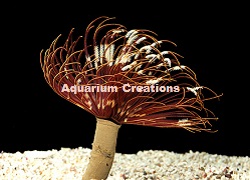
Description:
A beautiful addition to any reef tank. Colourful, hardy and peaceful toward virtually all other reef tank inhabitants, these forgiving fan worms are perfect for first-time reef-keepers but still able to start conversations among old-timers. If you have ever been fortunate enough to experience the mesmerizing effects of watching a Hawaiian feather duster retract with lightening quickness into its protective tube, you know what all the hubbub is about when it comes to this intriguing marine invertebrate. The umbrella-like crown, consisting of roughly 30 feathery radioles, or gills, of the Hawaiian feather duster can reach 7 or 8 inches in diameter, when extended fully outward. The individual feathers are tan, white, orange, brown, purple and other colors, with alternating brown bands. By waving its radioles, the Hawaiian feather duster creates its own gentle water movement that guides minute bits of plankton from the water column onto sticky tentacles and into its mouth, which is located in the center of the crown. The radioles of these unusual, segmented marine worms not only capture and provide food, but they aid in breathing too. Hawaiian feather dusters secrete mucous that bits of substrate adhere to and that produces a cocoon-like structure, described as being similar in look and feel to heavy paper or leather.
Tank Recommendations:
When feeding the Hawaiian feather duster, turn off protein skimmers for about one hour to make sure targeted food stays put. Likewise, intermittent stirring of the sandbed helps to suspend settled detritus back up into the water column where the worms can access it. While the Hawaiian feather duster is totally reef compatible, it may fall prey to aggressive fishes (e.g., dwarf angelfishes, some sea stars, etc.). They do best with peaceful fishes and invertebrates. Sandy, rubbly substrate assists feather dusters in building their tubes, while rock work is important for them to affix themselves to. Special note: The Hawaiian feather duster may drop its crowns if stressed. This is no cause for alarm as the crown will regenerate in time, although the source of the stress should be found and removed.
Food and diet:
Feed marine snow, phytoplankton, and/or foods for filter feeders.
Level of Care: Easy
Reef Compatibility:
Excellent
Approximate Purchase Size:
Medium: 2-1/2" to 3-1/2"; Large: 3-1/2" to 5-1/2"
|
Medium $12.99 ea.
Large $19.99 ea.
|
Fountain Head Feather Duster
Bispira brunnea
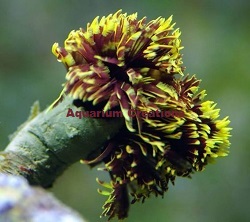
Description:
This is our most popular feather duster. Called the Fountain Head Feather Duster because of the shape of the top of the feather duster. A Brilliant Burgandy Red and Bright Yellow coloured, they are very hardy and peaceful toward virtually all other reef tank inhabitants, these forgiving fan worms are perfect for first-time reef-keepers but its beauty makes it popular with all level of aquarist's. By waving its radioles, the Fountain Head feather duster creates its own gentle water movement that guides minute bits of plankton from the water column onto sticky tentacles and into its mouth, which is located in the center of the crown. The radioles of these unusual, segmented marine worms not only capture and provide food, but they aid in breathing too. Fountain Head feather dusters secrete mucous that bits of substrate adhere to and that produces a cocoon-like structure, described as being similar in look and feel to heavy paper or leather.
Tank Recommendations:
When feeding the Fountain Head Feather Duster, turn off protein skimmers for about one hour to make sure targeted food stays put. Likewise, intermittent stirring of the sandbed helps to suspend settled detritus back up into the water column where the worms can access it. While the Fountain Head Feather Duster is totally reef compatible, it may fall prey to aggressive fishes (e.g., dwarf angelfishes, some sea stars, etc.). They do best with peaceful fish and invertebrates. Sandy, rubbly substrate assists feather dusters in building their tubes, while rock work is important for them to affix themselves to. Special note: The Fountain Head Feather Duster may drop its crowns if stressed. This is no cause for alarm as the crown will regenerate in time, although the source of the stress should be found and removed.
Food and diet:
Feed marine snow, phytoplankton, and/or foods for filter feeders.
Level of Care: Easy
Reef Compatibility
:Excellent
|
Price Each $24.99 ea.
|
Super Bright Nuclear Green Feather Dusters
Bispira sp.
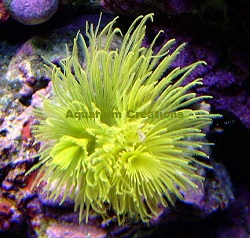
Description:
Bali provides us with a Nuclear Green Feather Duster, beautiful, easy to keep, perfect for the first time reef aquarist. Like it's larger Hawaiian cousin, it protects its segmented body by secreting a parchment-like tube to cover itself. When it is disturbed, it can quickly pull in its radiole into the tube. If it is severely stressed, it will discard its crown, growing it back later.The Flourescent Green Feather Duster is found in the coral rubble at the base of the reefs, with some of the rubble being incorporated into its parchment-like tube.
Tank Recommendations:
When feeding the Nuclear Green Feather Duster, turn off protein skimmers for about one hour to make sure targeted food stays put. Likewise, intermittent stirring of the sandbed helps to suspend settled detritus back up into the water column where the worms can access it. While the Nuclear Green Feather Duster is totally reef compatible, it may fall prey to aggressive fishes (e.g., dwarf angelfishes, some sea stars, etc.). They do best with peaceful fish and invertebrates. Sandy, rubbly substrate assists feather dusters in building their tubes, while rock work is important for them to affix themselves to. Special note: The Nuclear Green Feather Duster may drop its crowns if stressed. This is no cause for alarm as the crown will regenerate in time, although the source of the stress should be found and removed.
Food and diet:
Feed marine snow, phytoplankton, and/or foods for filter feeders.
Level of Care: Easy
Reef Compatibility:
Excellent
Approximate Purchase Size:
21/2" to 5"
|
Price Each $24.99 ea.
|






